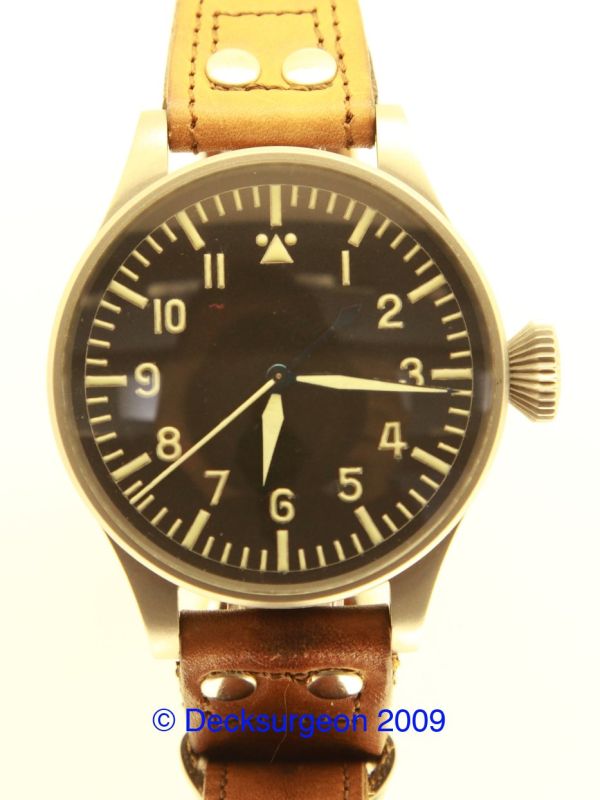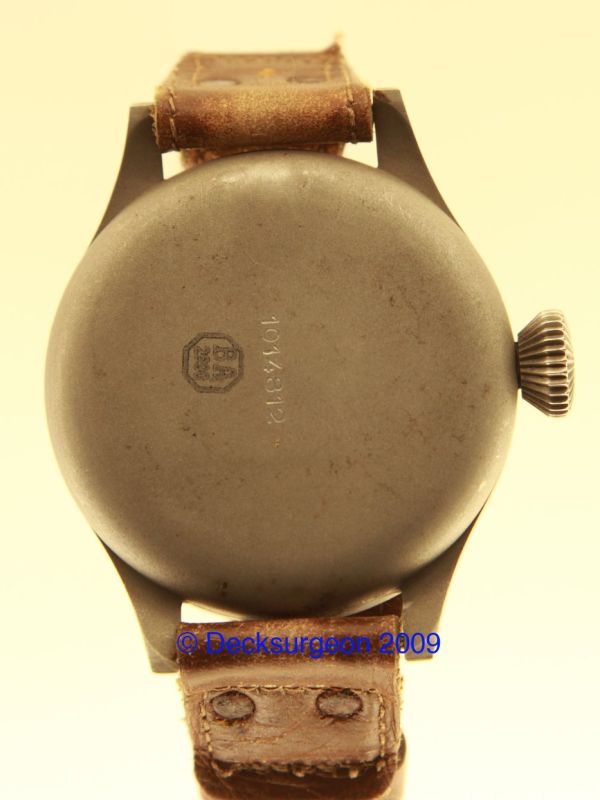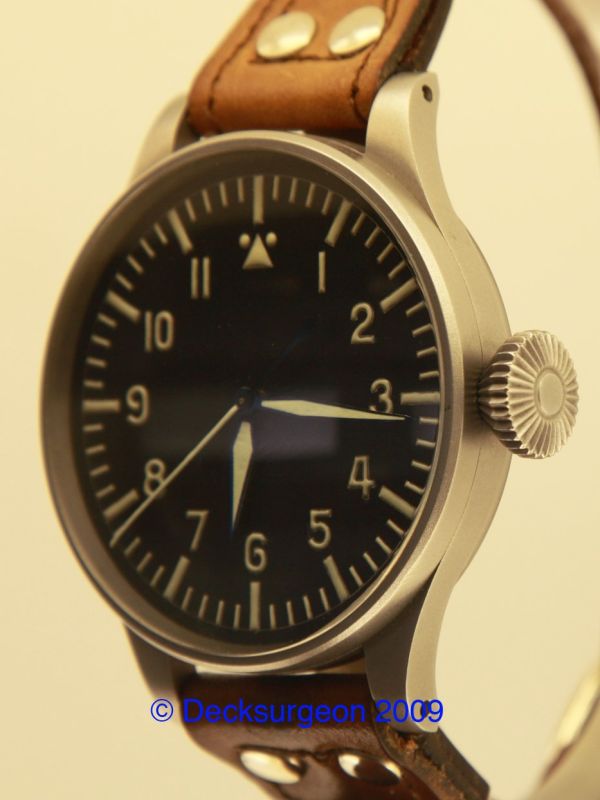© Decksurgeon May 2009
Der Grosse Fliegeruhr
It be near impossible to cover the sheer breadth and depth of the history of the pilot's watches from the very start to present day. But here are some interesting in an abridged presentation facts and some pictures of perhaps the most famous pilot's watch of them all.
The first airplanes had some form of cockpit watch. This was not a wristwatch but a modified pocket watch mounted on the instrument panel.
In a normal pocket watch the winding crown would be at the 12 o'clock position.
Just imagine this adapted pocket watch turned upsidedown and with the crown at 6o'clock. The makers then obviously had to rotate the dial thru 180 degrees correspondingly to have the numeric dial markers upright - this was one of the first so called "pilot's watches" in an aircraft.
From man's aviation infancy till present day. We have seen the pilot's watch evolve from an upside down mounted pocket watch to the fine antimagnetic products that ooze aesthetics combined with form and function that they are today.
There is no one single universal agreement on what constitutes to be a pilot's watch but the fundamental hallmarks desired are usually:
- Excellent legibility
- Clear and uncluttered styling
- Precise timing
- Excellent durability
- Anti-magetic
- Be able to cope with sudden loss of aircraft pressure
- Effortless operation by the pilot using gloved hands
It is easy to see then why a pocket watch was not the best solution for flying.
Today you probably wear your pilot's watch proudly at a board meeting or cruising in your German handmade sports car. However things were a little different a long time ago..........Altitude and speed created freezing cold temperature, and open cockpit exposed the pilot and watch to very fast winds and all sorts of weather. Pocket watches were not exactly the most practical thing to be hanging from a chain requiring intermittent extraction from a flying jacket requiring using gloved hands.
Present day: IWC Top Gun Doppel Chronograph in the Cockpit of an Audi R8

So Who commissioned the the first wristwatch for use in flight?
History often points the answer at one single individual named Albert-Santos-Dumont (the Cartier Santos is Named after him). He was an outstanding Brazilian born adventurer and aviator that was the first to commission a wristwatch designed for flying. His good friend Louis Cartier was more than happy to oblige by attaching a leather strap and buckles to a Cartier watch. Obviously the Cartier Santos we know today which was transpired from this original and does not look remotely like a pilot's watch. Credit must be given tho to Albert for his pioneering idea.
Albert Santos Dumont, Good friend of Louis Cartier - The Cartier Santos was the first "pilot's watch" actually

The wristwatch was a watch and indispensable instrument for flying for a multitude of practical reasons. The pilot's could check flight times, remaining fuel (via calculation), location (via calculation) et cetera. Time was inextricably intertwined with flight. This became extremely important during bombing missions of the WWII. Precision timing was then absolute necessity and specialized watches started to emerge.
Modern day pilot's watches are fundamentally shaped by one company - IWC (International Watch Company) based in Schaffausen , Switzerland.
IWC is not a newcomer or new kid on the block with a range of pilot's watches just because it's the 'in thing' to be selling today. IWC have in fact been involved in pilot's watches since 1930s. The very first IWC pilot's watch began life in 1936 and was dubbed "Special Watch for Pilot's". It basically combined all the features that were deemed necessary for its specific nature of function. It had high legibility and a rotating bezel that could be operated with a gloved hand.
IWC Ref 436 "Special Watch for Pilots", Shown is one from 1939. This was watch first produced in 1936.

This original 1936 watch also featured antimagnetic protection and this was a must give that aviation was increasingly exploiting new inventions in on transmitting devices, radios and radar.
At the beginning of WWII the German Luftwaffe / Reich's Aeronautics Ministry (RLM) collaborated with the German Naval Observatory and invited various watch companies to submit watches for testing. IWC (and other watch companies) were to develop and produce a very precise watch specially just for pilot's use. It was designed as a navigation watch or observation watch. The Germans demanded absolute precision and each individual piece was tested at the German Gesundbrunnen Marine Observatory in Glashutte before being released into service.
The institute assigned one of three classes: (1) Special Class (2) First Class (2) Second Class.
The IWC was assigned to "B" Watch (i.e navigation watch) First class. These standards also stipulated that the best materials and engineering components were to be used. They had to be equipped with high quality balances and have a specially treated balance spring with "breguet" curve. The was regulated in six positions at three different temperatures - YES! Three different temperatures.
There are very few manufacturers today that even attempt regulation at 3 differing temperatures. Documents from that era also confirm that the watches had to be reliable at -20 degrees C.
It was designed to be worn over the thick flying suit on the arm or even on the thigh - hence the over-long leather strap riveted to the strap attachments. The watch was not kept by the pilot but issued at the start of a mission and most certainly used as a navigational aid for night and long-range reconnaissance on long-distance flights. It may also have been used by bomber pilots also. However, it appears less likely that it could have been intended for fighter pilots or Stuka pilots.
The watch also had to have a "Hacking" mechanism (i.e. Second hand would stop when the crown was pulled) We take this for granted now, but back in the day the invention of stop-second itself was considered a complication on a watch. With the "hacking" feature the pilot could then synchronize his watch exactly with his counterparts or a known timing signal. Typically before a flight the watch would be synchronized with a Chronometer on the ground in the flight preparation room.
The Legendary IWC Ref 431, Big Pilot's Watch for German Air Force.
Shown here is an example from 1940

IWC choose the Cal 52 for the base and this was outfitted with some unique modifications. The exact designation of the Caliber used in the IWC "B-uhr" was "52T 19 H6 S.C". The 'T' stood for tirette which means hand setting by pulling on the crown. 19 is the movement diameter at 19 lignes (or 42.25mm) and H6 is the height of the movement at 6mm. The 'S.C.' meant that this movement had 'Seconde Centrale' and the gear mechanism for indirect propulsion of the central second hand by the elongated 3rd wheel pivot was added to the normal Cal 52.
The IWC Cal 52 as seen in a Pocket Watch (Without Center Seconds)

The IWC Cal 52T SC which powered the IWC Ref 431 Big Pilot's Watch for German Air Force

For the IWC enthusiast and collector you may wish to know that the IWC factory ledger list the diameter as not as 19 lignes but 19/22. The '22 lignes' appears because the movement was outfitted with a movement ring that increased the diameter to 22 lignes for fitment into the large case.
Mechanically this movement was top class Schauffhausen workmanship. 16 jewels, Swan neck fine adjustment, slit metallic balance with weight screws and fine adjustment screws. The balance spring was of the breguet overcoil variety terminal curve. The steel lever of the Swiss lever escapement was polished glossy but the escapement wheel was matte finish. The plates, bridges and movement ring was gold plated. The visible wheels were all embellished with a sunburst finish.
Der Grosse Fliegeruhr
It be near impossible to cover the sheer breadth and depth of the history of the pilot's watches from the very start to present day. But here are some interesting in an abridged presentation facts and some pictures of perhaps the most famous pilot's watch of them all.
The first airplanes had some form of cockpit watch. This was not a wristwatch but a modified pocket watch mounted on the instrument panel.
In a normal pocket watch the winding crown would be at the 12 o'clock position.
Just imagine this adapted pocket watch turned upsidedown and with the crown at 6o'clock. The makers then obviously had to rotate the dial thru 180 degrees correspondingly to have the numeric dial markers upright - this was one of the first so called "pilot's watches" in an aircraft.
From man's aviation infancy till present day. We have seen the pilot's watch evolve from an upside down mounted pocket watch to the fine antimagnetic products that ooze aesthetics combined with form and function that they are today.
There is no one single universal agreement on what constitutes to be a pilot's watch but the fundamental hallmarks desired are usually:
- Excellent legibility
- Clear and uncluttered styling
- Precise timing
- Excellent durability
- Anti-magetic
- Be able to cope with sudden loss of aircraft pressure
- Effortless operation by the pilot using gloved hands
It is easy to see then why a pocket watch was not the best solution for flying.
Today you probably wear your pilot's watch proudly at a board meeting or cruising in your German handmade sports car. However things were a little different a long time ago..........Altitude and speed created freezing cold temperature, and open cockpit exposed the pilot and watch to very fast winds and all sorts of weather. Pocket watches were not exactly the most practical thing to be hanging from a chain requiring intermittent extraction from a flying jacket requiring using gloved hands.
Present day: IWC Top Gun Doppel Chronograph in the Cockpit of an Audi R8

So Who commissioned the the first wristwatch for use in flight?
History often points the answer at one single individual named Albert-Santos-Dumont (the Cartier Santos is Named after him). He was an outstanding Brazilian born adventurer and aviator that was the first to commission a wristwatch designed for flying. His good friend Louis Cartier was more than happy to oblige by attaching a leather strap and buckles to a Cartier watch. Obviously the Cartier Santos we know today which was transpired from this original and does not look remotely like a pilot's watch. Credit must be given tho to Albert for his pioneering idea.
Albert Santos Dumont, Good friend of Louis Cartier - The Cartier Santos was the first "pilot's watch" actually

The wristwatch was a watch and indispensable instrument for flying for a multitude of practical reasons. The pilot's could check flight times, remaining fuel (via calculation), location (via calculation) et cetera. Time was inextricably intertwined with flight. This became extremely important during bombing missions of the WWII. Precision timing was then absolute necessity and specialized watches started to emerge.
Modern day pilot's watches are fundamentally shaped by one company - IWC (International Watch Company) based in Schaffausen , Switzerland.
IWC is not a newcomer or new kid on the block with a range of pilot's watches just because it's the 'in thing' to be selling today. IWC have in fact been involved in pilot's watches since 1930s. The very first IWC pilot's watch began life in 1936 and was dubbed "Special Watch for Pilot's". It basically combined all the features that were deemed necessary for its specific nature of function. It had high legibility and a rotating bezel that could be operated with a gloved hand.
IWC Ref 436 "Special Watch for Pilots", Shown is one from 1939. This was watch first produced in 1936.

This original 1936 watch also featured antimagnetic protection and this was a must give that aviation was increasingly exploiting new inventions in on transmitting devices, radios and radar.
At the beginning of WWII the German Luftwaffe / Reich's Aeronautics Ministry (RLM) collaborated with the German Naval Observatory and invited various watch companies to submit watches for testing. IWC (and other watch companies) were to develop and produce a very precise watch specially just for pilot's use. It was designed as a navigation watch or observation watch. The Germans demanded absolute precision and each individual piece was tested at the German Gesundbrunnen Marine Observatory in Glashutte before being released into service.
The institute assigned one of three classes: (1) Special Class (2) First Class (2) Second Class.
The IWC was assigned to "B" Watch (i.e navigation watch) First class. These standards also stipulated that the best materials and engineering components were to be used. They had to be equipped with high quality balances and have a specially treated balance spring with "breguet" curve. The was regulated in six positions at three different temperatures - YES! Three different temperatures.
There are very few manufacturers today that even attempt regulation at 3 differing temperatures. Documents from that era also confirm that the watches had to be reliable at -20 degrees C.
It was designed to be worn over the thick flying suit on the arm or even on the thigh - hence the over-long leather strap riveted to the strap attachments. The watch was not kept by the pilot but issued at the start of a mission and most certainly used as a navigational aid for night and long-range reconnaissance on long-distance flights. It may also have been used by bomber pilots also. However, it appears less likely that it could have been intended for fighter pilots or Stuka pilots.
The watch also had to have a "Hacking" mechanism (i.e. Second hand would stop when the crown was pulled) We take this for granted now, but back in the day the invention of stop-second itself was considered a complication on a watch. With the "hacking" feature the pilot could then synchronize his watch exactly with his counterparts or a known timing signal. Typically before a flight the watch would be synchronized with a Chronometer on the ground in the flight preparation room.
The Legendary IWC Ref 431, Big Pilot's Watch for German Air Force.
Shown here is an example from 1940

IWC choose the Cal 52 for the base and this was outfitted with some unique modifications. The exact designation of the Caliber used in the IWC "B-uhr" was "52T 19 H6 S.C". The 'T' stood for tirette which means hand setting by pulling on the crown. 19 is the movement diameter at 19 lignes (or 42.25mm) and H6 is the height of the movement at 6mm. The 'S.C.' meant that this movement had 'Seconde Centrale' and the gear mechanism for indirect propulsion of the central second hand by the elongated 3rd wheel pivot was added to the normal Cal 52.
The IWC Cal 52 as seen in a Pocket Watch (Without Center Seconds)

The IWC Cal 52T SC which powered the IWC Ref 431 Big Pilot's Watch for German Air Force

For the IWC enthusiast and collector you may wish to know that the IWC factory ledger list the diameter as not as 19 lignes but 19/22. The '22 lignes' appears because the movement was outfitted with a movement ring that increased the diameter to 22 lignes for fitment into the large case.
Mechanically this movement was top class Schauffhausen workmanship. 16 jewels, Swan neck fine adjustment, slit metallic balance with weight screws and fine adjustment screws. The balance spring was of the breguet overcoil variety terminal curve. The steel lever of the Swiss lever escapement was polished glossy but the escapement wheel was matte finish. The plates, bridges and movement ring was gold plated. The visible wheels were all embellished with a sunburst finish.















 ! Tx for sharing
! Tx for sharing .
.




Comment